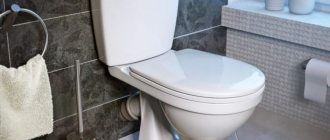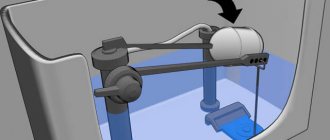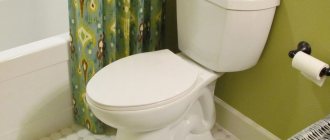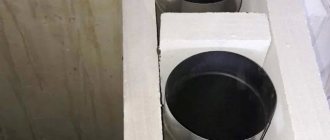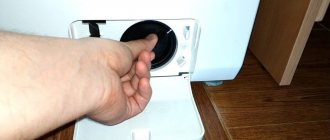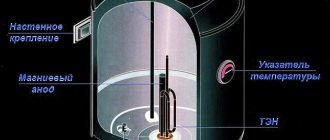Nowadays there is a toilet in any private house or apartment. Manufacturers of this plumbing equipment are constantly improving the design, inventing new components. As a result, various shapes and dimensions of toilets and cisterns have been created with their own characteristics of draining and filling with water. Sometimes breakdowns occur that reduce the quality of the drain. To solve a problem, you need to find the cause in time.
Chemicals for toilet cleaning
Today there are a huge number of special compounds on sale, so the problem of how to clean the toilet simply does not arise.
It is worth noting that there are means that allow you to specifically combat urinary stones, rust and limescale. To know how to clean a toilet tank, you must carefully read the instructions for the selected product. With preparations that allow you to quickly clean the toilet from dirt, you should work exclusively with rubber gloves, special glasses and respirators. Otherwise, you may get a chemical burn to the skin, lungs, or eye damage.
Orthophosphoric acid
One of the effective answers to the question of how to clean a toilet from urinary stones is phosphoric acid. This is a fairly strong product that removes not only the corresponding plaque, but also any rust both in the tank and in the toilet bowl.
How to clean a toilet tank using this acid? To do this, take about one hundred and fifty grams of acid and pour it into the tank, wait no more than fifteen minutes and thoroughly rinse the internal surfaces with running water. This substance copes excellently with all kinds of contaminants, but does not have a destructive effect on rubber inserts and drain fittings if they are made of plastic.
Hydrochloric acid
Many people are interested in how to clean a toilet from plaque using hydrochloric acid? In principle, this is quite possible, but you should use this product as carefully as possible: the fact is that this substance is caustic - if it gets into the respiratory tract or on the skin, it can cause serious harm to health.
Regarding how to clean a toilet from stone with hydrochloric acid, there is the following method: take approximately one hundred grams of such acid, mix with the same amount of water, pour it into the toilet bowl and leave it there for about ten minutes.
You must first make sure that the diluted acid will not be in direct contact with rubber or plastic products, as it can dissolve them very quickly.
Chlorine-containing products
Most products aimed at cleaning the toilet from various contaminants contain chlorine. Its vapors are very dangerous for humans, so you can use such means only if no other method has helped.
Various powders cope quite effectively with stains, but it should be remembered that they should be used as carefully as possible, as they can form very small scratches into which dirt, lime and other similar substances will accumulate.
Replacing the drain fittings in the tank
In order to completely replace the drain fittings in the tank , it is necessary to perform a series of sequential operations.
- Shut off the water in the supply flexible hose.
- Unscrew the decorative ring of the button on the top cover of the cistern.
- Disconnect the flexible water supply hose to the drain tank.
- Remove the top cover of the cistern.
- Rotate 90 degrees and remove the top of the drain column.
- Disconnect the flush tank from the toilet bowl.
- Place the cistern body on the toilet body.
- Unscrew the nuts securing the valve system and drain column.
- Remove the remaining part of the drain column.
Components of the drain column
You can inspect the dismantled drain column and replace worn parts in it. This plastic design is not particularly reliable, so almost anything in it can break.
Installation of a repaired or new drain column into the tank is carried out in the reverse order of the installation algorithm.
As you can see, the reasons for poor toilet flushing may lie in the inadequate operation of various equipment, but any such malfunction can be easily fixed with your own hands.
Watch the video tutorial to learn more about the process of repairing plumbing fixtures.
Prices for plumbing cable
plumbing cable
What to do if the plastic cover has turned yellow
It happens that over time the plastic on the lid turns yellow. To whiten the toilet lid from yellowness, it is best to remove it first, if the design of the toilet allows it. If this cannot be done, apply all the products described below with a sponge and leave for a while. If you still managed to remove the lid, then clean it by soaking.
In the fight against old fat, ordinary baking soda (sodium bicarbonate) dissolved in very hot water will come to the rescue.
Take an enamel basin or steel pan, immerse contaminated items in it, add soda at the rate of 2-3 tablespoons per liter of water and fill with hot water. The higher its temperature, the more intense the process of fat breakdown will occur, so it is best to pour boiling water over the kitchen utensils from a just boiled kettle. To improve the effect, you can add a little dishwashing liquid. Leave for 30-40 minutes. You can periodically add boiling water to the basin to keep the water warm.
After this, remove the kitchen utensils from the soda solution and wipe them with a sponge or dish brush. The remaining undissolved fat should come off easily and quickly. After this, rinse the cleaned items thoroughly under running warm water.
If the items are too dirty, you can increase the exposure time of the soda solution to one and a half to two hours. During this time, even the most “difficult” fatty stains will come off. But in this case, it is better to put the basin or pan on the stove at minimum heat, keeping the water hot - or bring it to a boil every 10-15 minutes, turning off the stove in between.
How to remove the lid from the tank
If the tank stops filling, begins to leak, or water continuously pours into the bowl through the overflow tube, the fittings need to be adjusted or replaced. To access the inside of the tank, you must remove the lid.
Difficulties may arise if a flush tank mechanism with a button is installed. To remove the button on the cover, you need to press it and turn the ring. If you cannot turn the flat ring with your fingers, you need to press the button and find special slots on the inner rim of the ring. By inserting a narrow flat screwdriver into one of the slots, turn the ring and then unscrew it with your fingers.
The button ring can be easily unscrewed with your fingers Source psk-remont.ru
After the button is removed (by removing the ring, just pull it up), you can easily remove the cover and examine the structure of the drain tank, checking the mechanisms for damage.
How to get rid of old plaque
It happens that you get a toilet in a fairly neglected state. No store-bought products in tandem with a brush can cope with existing stains. Then it is necessary to connect heavy artillery.
Household chemicals containing acid
The easiest way to clean a toilet from old plaque is to use household chemicals available on the market
In this case, it is necessary to pay attention to those products with which you need to use a protective mask. Only they are able to cope with strong and old pollution
Coca Cola
No matter how funny and strange it may sound, housewives have repeatedly tested and proven that Coca-Cola can cope with many contaminants. Cleaning the toilet was no exception.
In order to clean the accumulated plaque and deposits, you just need to pour a bottle of the drink into the toilet and leave it to stand for several hours. After this, work a little with a brush and drain the water.
Oxalic acid
Oxalic acid is a crystalline powder. You need to work with it exclusively in thick rubber gloves. It is applied with a sponge to the toilet lid and under the rim. For ease of application, use a damp sponge.
If there is heavy dirt at the bottom of the toilet, pour powder inside. Wash off after a few hours.
Electrolyte
The most powerful, but at the same time, the most difficult to use toilet cleaner. The difficulty lies in the strong toxicity of the electrolyte. With it you need to provide yourself with maximum protection. In addition to thick rubber gloves, you should wear a protective mask, your body should be hidden as much as possible under thick clothing, and it would be a good idea to wear goggles to protect your eyes.
Since the electrolyte is a liquid, you just need to pour it into the toilet, doing this very carefully, avoiding splashes. After 15 minutes you can drain the water
White
If you want to achieve maximum whiteness of the toilet, then this product will do the job perfectly. “Whiteness” just needs to be poured into the toilet bowl and left there, flushed after a few hours.
After leaving the toilet with the cleaner overnight, it will be good if you remove the deposits in the morning using a wooden spatula or a construction spatula. This option is suitable for very large stone deposits. The stone will become wet under the influence of chemicals and will easily come off in pieces from the surface.
Basic steps for cleaning a toilet:
- Preparatory stage - we empty the bathroom of things and unnecessary items: personal hygiene products, towels, paper, trays with fillings for animals, etc. We prepare cleaning products and protective equipment - glasses, gloves, respirators, brushes, washcloths, rags, a special brush for cleaning, cleaning solutions and products for disinfection and aromatization.
- Main stage:
- wash the outside of the toilet, starting with the drain pipes, glass, outer part and ending with the lid;
- clean the inside of the toilet - remove dirt from under the rim, then from the flat part of the toilet and the hole;
- We clean the toilet lid - spray the cleaning agent on the seat and rim of the toilet, not forgetting about the fastening system.
- Final stage: remove excess liquid and remaining drops of cleaning solutions, wash and collect brushes and used tools, lay out consumable personal hygiene items, place fragrance and ventilate the room
Advice: after you have washed the toilet, you should throw away the soft sponges and wash the rags using the maximum temperature setting of the washing equipment. It is best to use disposable paper towels and napkins for cleaning the toilet, but not everyone can afford this.
Important! It must be remembered that chemical cleaning and disinfection products are toxic to others, so they should be stored in a locked place inaccessible to children and pets.
If you do not want to use chemicals, you can effectively clean the toilet using vinegar essence and baking soda powder.
Plaque removers
To combat urinary stones or an unsightly limescale layer, they use both store-bought and folk remedies that can cope with the task no worse.
An additional advantage of such products is aromatization, that is, the toilet will be clean and smelling good. The tablets can be easily purchased in any hardware department of the supermarket.
Professional
Store shelves now offer a huge range of cleaning products that can combat limescale and other types of dirt.
They have two main advantages:
- Thanks to the curved neck, the gel penetrates under the rim of the toilet bowl and into hard-to-reach places.
- Low consumption of substance. Very little product is needed for cleansing. There are clear instructions on the back of the bottle, which describe different options for washing your plumbing fixtures.
All sold cleaners are aimed not only at getting rid of plaque and urinary stones. Secondary tasks are keeping the toilet fresh, eliminating unnecessary odors, and most importantly, disinfecting the surface.
The most common and effective gels:
- Domestos;
- Duckling 3 in 1;
- Bang;
- Toilet Yplon;
- DOSIA.
Despite a lot of advantages - from ease of use to amazing efficiency, there is a significant disadvantage. All products are chemical products, and they are also caustic, which can cause allergies, damage to the skin and respiratory tract.
Folk
Almost every housewife has a whole arsenal of folk recipes for combating limescale in the toilet. All ingredients are easy to find in a regular kitchen or at your local store.
- Coca Cola. A drink with such a famous name is used not only as a thirst quencher. The substances included in its composition help remove a thin layer of lime. To clean, pour Coca-Cola directly into the toilet along the rim. Leave for an hour. Then wipe the surface with a sponge and rinse.
Vinegar. A glass of 9% vinegar is heated in a saucepan until warm. After this, add 1 tablespoon of baking soda. The resulting solution is applied to contaminated areas and left overnight. In the morning, all that remains is to wash off the product.
Lemon acid. This is the most popular method. Limescale is sprinkled with citric acid. After 3 hours of exposure, the remaining deposits are easily removed with a sponge. The only negative is the inconvenience of use on vertical surfaces.
White. This liquid helps housewives when they need to bleach things or remove stains on light-colored surfaces. For the best effect, you must first rid the toilet of water and dry it with paper towels. Then apply white liberally to the stained areas. For exposure, the plumbing fixtures are left alone under a closed lid for 8–12 hours.
Oxalic acid. Another effective method for cleaning a toilet is using oxalic acid. Just before use, you should know that you need to wear rubber gloves when working with this product. Oxalic acid is applied to the abrasive side of a damp sponge, which is used to rub the areas damaged by plaque. After completing the procedure, the toilet is washed generously with water.
Cleaning products
Baking soda is considered the most versatile cleaning agent. If the damage to the surface is small, use a soft sponge to rub a sufficient amount of the substance and leave for 50-60 minutes. Then rinse with warm water. In case of old yellow stains, ammonia is added to it. Having mixed both components until a viscous mass is formed, the latter is applied to the yellowed area for 30 minutes. After time has passed, the mixture is rinsed with water. The soda effect will be noticeable after the first use. This completely eliminates damage to the enamel.
Vinegar combats the problem of yellow streaks no less effectively. In addition to cleaning, it has a powerful disinfectant. property. All you need to do is apply it to the surface of the plumbing and leave for 1 hour. Its inherent pungent odor will gradually dissipate after rinsing with water. In addition to vinegar, you can use paper napkins pre-soaked in it. So, covering the bathtub or toilet with them an hour after flushing, the absence of contamination is guaranteed.
Citric acid can have a similar effect, which can be used as follows. Two 100 gram packs of citric acid are added to the hot water previously collected in the bathroom. The solution is left in this state overnight. In the morning, the final stage of the cleaning procedure is carried out in the standard way, namely with the help of sponges. It is better if there are several of them, since this substance actively dissolves fat.
To keep the bathroom and toilet constantly clean and not subject to mechanical damage, certain rules should be followed:
- Even if the degree of contamination is severe, only soft sponges are used for plumbing. Hard brushes quickly damage the enamel, resulting in cracks.
- Sharp contrasting water temperatures should not be allowed. This has a detrimental effect on the enamel of the plumbing fixtures.
- Avoid soaking laundry in the bathroom. Washing powders corrode any bathroom coating.
It is advisable to combat any type of pollution at the stage of its occurrence.
It is enough to pay due attention to cleaning your plumbing fixtures once a week to forget about the problem of yellow streaks forever.
How to remove not too old plaque
If you always try to keep your toilet clean, according to the recommendations above, then the maximum that awaits you is to occasionally remove the yellowness from the toilet seat and its surface. Let's look at all the possible means that do an excellent job with this.
Table vinegar
Cleaning is done as follows:
In a saucepan or any container convenient for you, heat about one glass of vinegar until warm.
- Pour the heated vinegar into the toilet bowl and add two teaspoons of baking soda there.
- Leave to stand overnight.
- In the morning, it will be enough to just flush the toilet with a brush and drain the water.
If you only need to wash the toilet lid from yellowness, then you need to:
- In a small container, mix warm vinegar and baking soda.
- Wearing rubber gloves, quickly apply this mixture with a sponge.
- Leave for 15-20 minutes and then rinse with a clean sponge.
Lemon acid
Another remedy for removing old plaque is citric acid.
This procedure is incredibly simple and convenient. All you have to do is pour a couple of citric acid packets into the toilet and leave it all to react overnight. After the chemical reaction takes place, you just need to clean the toilet with a brush and drain the water.
The tank is leaking
Also, water may not be collected due to the fact that it flows into the drain hole without permission.
There may be three reasons:
- The rubber from which the valve that closes the hole is made (pear or petal) has lost its elasticity due to natural aging. The part is replaced with a new one;
- the valve does not fit tightly to the seat due to deposits. Methods for removing deposits are described above;
- The drain mechanism rods are jammed or it is damaged. In the first case, the rods are adjusted, in the second, the mechanism is changed.
Salt and sand
Washing glassware in salt water will prevent streaks and restore shine to your glassware. Fill a basin with warm water. Dissolve 2-3 tbsp in it. l. salt. Rinse the glass in the prepared solution and dry without wiping.
Another way to use salt will clean the glass from plaque, dirt and stubborn grease. Before you start washing, wet the dishes with water and roll them in fine salt. Leave for half an hour. After this, remove the dirt with a sponge or foil and rinse with warm water.
Salt and sand will do a good job of removing stubborn dirt, cleaning dishes from carbon deposits, and also increasing the product’s resistance to external influences. To do this, it is enough to temper the glass product.
Pour sand into the bottom of a deep pan. Place glass utensils on it and fill it with water purified from impurities. Bring the liquid to a boil. Reduce the temperature to low and soak the dishes in hot water for 15-20 minutes. Add 2 tbsp. l. table salt and boil the glassware for another 30 minutes. Remove the pan from the stove and let the liquid cool naturally. Remove the dishes and rinse in cool water.
To make washing glassware less hassle, use the following tips:
- Be sure to remove jewelry from your hands before washing. Otherwise, there is a risk of scratching or damaging fragile dishes.
- Use only soft sponges and medium-hard brushes.
- Do not use washing powder.
- Avoid sudden changes in water temperature.
What not to use
The following should not be used when cleaning the tank:
- boiling water and hot water (high temperatures can cause earthenware to crack, and plastic items to become deformed);
- metal brushes (scratches are a favorable condition for the development of plaque in the future);
- sand and other coarse abrasives.
If the toilet is connected to plastic pipes, do not use electrolyte or products containing hydrochloric acid. The chemical corrodes the plastic and causes the pipes to leak.
Folk remedies for cleaning dishes
There are many means for removing fresh and stubborn stains from kitchen utensils.
Moreover, you can make an effective and safe composition from improvised means that are present in every home. Most often used for these purposes:
- soda;
- lemon acid;
- table vinegar;
- salt;
- laundry soap;
- vegetable oil;
- PVA glue;
- dry mustard.
These folk remedies help, and when mixed, the result is achieved many times faster.
Citric acid, table vinegar and soda
To clean the lid and itself, especially the areas near the handles and under the rim, do the following:
- Prepare a container to accommodate the dishes.
- Pour water.
- For one liter of water, add a glass of vinegar (9%) and citric acid (25 grams).
- Place the container on the stove and wait until it boils.
- Place the dishes in the mixture and cook over low heat for 30 minutes.
- Turn off the stove and leave until cool.
Remove the dishes and wash off the grease and residue under running water.
Citric acid with baking soda
If you need to wash off grease on plates and utensils made of plastic, glass or ceramic vases:
- Combine 2 tablespoons of citric acid and soda.
- Apply the paste onto the wetted surface.
After the interaction of soda and citric acid, the fat will begin to dissolve and can be easily removed with a sponge.
Baking soda combined with salt and vinegar
You can also boil dishes in a water-soda solution.
To do this, boil for at least 1 hour, after which fat and carbon deposits are removed with a sponge under running water.
But if you need to clean a large aluminum pan or stove top, do the following:
- Wash the surface with hot water and any detergent.
- Mix equal amounts of baking soda, 9% vinegar and salt.
- Apply the paste onto the pan.
- Leave it to sit for a couple of hours.
Loose fat is easily removed with a sponge. Be sure to rinse the dishes well and wipe dry.
Laundry soap and glue
Regular laundry soap in combination with PVA glue will help you easily remove old grease from dishes.
For this:
- Pour 5 liters of water into a large container.
- Add 3 tablespoons of laundry soap shavings and the same amount of PVA glue.
- Place the container on the fire and boil the solution.
- Place dirty dishes into the boiling liquid.
- Boil for about 1 hour, adding water periodically.
After partial cooling, remove old fat and carbon deposits from the surface with the hard side of the sponge.
This method will help clean even an old frying pan from heavy carbon deposits.
How to keep your toilet clean
Having figured out where the yellow plaque on the toilet comes from, it’s time to find out how to deal with it. The easiest way to prevent the formation of urinary stones is regular cleaning, because it is always easier to carry out regular maintenance and keep the plumbing clean than to make efforts to remove old dirt.
You can keep your toilet clean and white in the following ways:
- regularly flush the water from the cistern after each visit to the toilet;
- daily remove splashes and drops from the toilet lid with toilet paper or a damp cloth;
- Once every few days, apply a toilet cleaner to the surface of the toilet to prevent the appearance of plaque;
- You can use special cassettes that are attached to the toilet, under the lid, and every time you press the flush button, a special product enters the toilet along with the water, which fights the formation of dirt and also has a pleasant aroma.
Cleaning the toilet correctly
It’s unpleasant to see a dirty toilet when entering the bathroom in the country. Besides, if he spreads an unpleasant smell throughout the room, then he is in it, there is no desire.
With a little effort (usually the procedure takes no more than 10-15 minutes), the toilet will regain its sparkling shine and get rid of the unpleasant odor.
Required Tools
- Ershik. At the moment, there are various configurations of the tool, but it is better to purchase models equipped with an additional nozzle for cleaning the toilet rim.
- Hard sponge. This tool is individual, and it is recommended to use it only in this case, periodically replacing it with new ones.
- Pumice. Ordinary foot cleaning products will not be useful in this case. Here you need a model equipped with a wooden handle or stick.
- Individual protection means. This set includes rubber gloves, a face mask and a special oilcloth apron.
Cleaning the inside of the toilet
The inside of the toilet is the dirtiest place and needs constant cleaning. And even despite the apparent cleanliness of the device, it needs periodic disinfection. For cleaning, liquid, powder or gel-like products can be used. Also, effective folk remedies are acceptable.
Cleaning plumbing inside:
- Remove water from the inside of the toilet. How to drain water from a toilet for cleaning? This is done in several ways: with a ladle or measuring cup, a technical syringe, or an empty shampoo bottle.
- Wear personal protective equipment.
- Use one of the selected cleaning products to fill the walls of the interior of the plumbing fixture.
- It is recommended to leave it in this state for at least a couple of hours.
- Taking a brush in your hands, thoroughly clean the surface. Do not forget that under the rim the main accumulation of bacteria and therefore this part of the toilet needs special attention.
- Drain the water from the tank.
- Re-treat the ceramic with a brush to remove any remaining cleaning agent.
- No foam should form after rinsing. In this case, we can assume that there are no traces of detergent left on the coating.
Cistern. Cleaning Rules
This is a place that also needs periodic cleaning - for example, once every 2 months. Stagnant water leaves a coating on the walls of the tank, thereby forming unpleasant odors and contributing to the destruction of connections of internal elements.
Let's start cleaning:
- We turn off the water.
- We flush the water from the tank.
- Remove the cover.
- Wearing gloves, apply the selected product to the walls of the tank.
- Rub it with a damp cloth and leave for half an hour.
At the final stage, it is necessary to draw and drain water several times. In this case, you can help with a rag, wiping the inside surface of the water container. Don't forget to close the lid and turn on the water supply.
Cleaning the outside of the toilet
The outer surface is easier to clean, but it is necessary to understand and know the secrets and rules of processing. In fact, the outer part is processed much faster than the rest. To do this, just take a damp cloth and wipe the entire surface. For disinfection, it is necessary to carry out treatment with a rag soaked in alcohol.
Seat cover
Do not neglect cleaning this element of the plumbing fixture. Since it has direct contact with the body, its treatment should be a priority.
Cleaning process:
- Remove the rim from the mountings.
- Get wet.
- Using a sponge and cleaning agent, scrub all parts of the rim.
- In the bathroom, under a strong stream, rinse off any remaining detergent.
- Using a dry cloth, wipe the entire surface of the lid.
Proper cleaning of the ceramic surface of the toilet will make it sparkle with cleanliness.
Products from the kitchen
Every kitchen has universal means for washing dishes, removing clogs and dirt from all surfaces:
- vinegar;
- soda;
- lemon acid;
- white.
They are used to remove limescale from the toilet and clean it until it shines.
It is preferable to get 70% vinegar, vinegar essence. It is poured into the toilet, approximately 200 - 250 ml and 100 ml into the tank, covered with a lid and left for 15 - 20 minutes. After this, rub all surfaces well with a brush or steel wool and rinse. When the tank is full, it is advisable to rinse it again.
To use 9% vinegar, before removing limescale, you need to remove water from the siphon, otherwise the concentration of the acid solution will be weak and will not cope with limescale, especially urinary stones. Water can be removed by pushing it with a plunger, scooping it out with a glass, or soaking it with a rag.
A 500 ml bottle of vinegar is poured into the toilet, into the low tide, which is the hardest to clean and collects the thickest layer of dirt. Then paper napkins are moistened and placed under the rim; you can cover the entire surface of the bidet with them. Cover with a lid for about an hour. Then clean everything well with a brush, rub hard-to-reach places in the knee with a washcloth or toothbrush. Remove the napkins. Rinse everything off with water and ventilate the toilet to remove the smell of vinegar.
How to remove plaque with a large layer of urinary stone. Add 50 drops of iodine and a tablespoon of soda to vinegar heated to 45 - 50 degrees. Pour into a toilet bowl that has been emptied of water and close the lid for 2 to 3 hours. Then wipe off the red coating and rinse it off the tank with water.
How to remove plaque if you don’t have vinegar on hand. It is enough to sprinkle a pack of citric acid evenly at night. In the morning, clean and rinse. The product is gentle and may not wash off in one go. With regular use of citric acid, the toilet bowl will shine.
Baking soda is also used when it is necessary to clean the toilet from yellow plaque. Urine stone contains acid and becomes loose after interaction with alkalis. Pour out the baking soda and after a couple of hours wipe the surface with a napkin.
Rust is difficult to clean off and requires a lot of effort or combined preparations. This is exactly what the carbonated drink Coca-Cola is. If you remove the sugar, then the content of acids and alkalis in cola is practically not inferior to detergents. It corrodes lime, removes carbon deposits, and destroys urinary stones. The drink is often used to remove rust.
Take a 2 liter bottle and pour it into the toilet, wetting the entire surface and under the rim. After a couple of hours, go over with a brush and rinse with water. Should be considered. That the drink corrodes aluminum parts.
How to remove heavy dirt and quickly achieve results at home. Often, having moved to a rented apartment, people try to invite friends and do not want the red toilet to spoil the mood. There is no time for several stages of the struggle. It is necessary to use a universal bleaching and disinfectant – Whiteness. This is an aqueous solution of chlorine with aromatic additives.
Select water from the siphon. Pour 500 ml of bleach into the bidet and wet the entire surface evenly. Add 100 ml to the tank. Chlorine is harmful to humans, so in addition to gloves, you need a mask. Whiteness should be poured at a time when no one is at home. Leave for at least 8 hours, preferably 12, and wash off. Then rinse again.
With regular use of Whiteness, it can be sprayed once a week over the entire internal surface. Close the lid for 20 - 30 minutes. Flush and ventilate the bathroom to remove the smell of chlorine.
How to get rid of plaque using folk remedies
Plaque and rust in the toilet bowl can be removed using a whole list of folk remedies, and they work just as effectively as purchased chemical compounds, and high-quality products will be quite expensive, and cheap ones will not help cope with the question of how to properly clean the toilet.
Lemon acid
When wondering how to clean a toilet from limescale, you need to remember that its key enemy is citric acid. It is capable of quite effectively dealing with various kinds of deposits, if they have not yet become too hardened.
To deal with citric acid contamination, you need to do the following:
- take about three or four sachets of this product;
- apply them to areas where such contamination has occurred;
- close the toilet lid and leave it in that position for several hours;
- Water washes off both the citric acid itself and the impurities.
To return the ceramics to their original appearance, this procedure must be repeated several times.
Soda with vinegar
You can try using baking soda and vinegar. The vinegar essence is first properly prepared. This should be done as follows:
- take about 250 grams of essence or food vinegar;
- heat it to a temperature of about 50 degrees (this must be done with the lid closed to prevent a strong odor);
- the warm solution is poured into the toilet. To make the effect more noticeable, you can clean the toilet with soda, which is added to the vinegar solution;
- Be sure to close the plumbing and leave it overnight.
After this, rinse the toilet bowl with plenty of water and wipe it with a brush or other relatively soft brush.
Oxalic acid
Oxalic acid is not too expensive, and using it to clean the toilet from rust, limescale and urinary stone is very simple: take a soft cloth, lightly moisten it in water, then pour the acid onto the dirty areas. It's not worth saving on it. The acid is given some time so that it has time to corrode the contaminants - one hour is enough.
Its important advantage is the absence of an unpleasant odor; in addition, its use is the answer to the question of how to clean a lint toilet brush white.
Causes of plaque
Most plumbing fixtures are resistant to small deposits. But despite this, faucets easily lose their appearance, and a “damaged” toilet looks unpresentable.
There are several reasons that contribute to the greatest plaque formation.
- The more often family members use water, the thicker the limescale layer in the toilet.
- The lack of filters makes the situation worse.
- Toilets with a rough surface due to age or damage are more quickly covered with lime, urinary stone, and are more difficult to clean.
If the plumbing is in poor condition, water is constantly dripping from the toilet tank or sink, then traces of the limescale layer will always be on the walls of the plumbing equipment.
Reasons why the toilet doesn't flush well
The ways to solve the problem and the sequence of actions largely depend on what exactly caused it. Often the reason lies in the sewer outlet pipe. Due to its blockage, wastewater cannot pass through. In another case, the problem is hidden in the drain tank.
Sometimes, due to the breakage of the hollow plastic bulb, a little liquid accumulates in the tank. Defects appear in the vessel, due to which it fills with water. As a result, it sinks deeper into the water than necessary.
A metal lever in the form of a rod is used to secure the vessel. It bends when used. This causes malfunctions in the opening and closing system of the outlet. If the outlet valve is not working properly, the tank does not fill completely. And the outlet often becomes clogged with suspended matter present in the water. Sometimes the sealing parts of the release device wear out or the button in the reservoir cap breaks.
It is not difficult to understand why the water in the toilet does not flush:
- When a pipe becomes clogged during flushing, water accumulates in the toilet bowl. Its level rises greatly above normal, and leakage occurs slowly.
- The lack of water in the tank is easily determined by a simple inspection.
- The failure of the bulb is determined after opening the lid of the drain tank and inspecting the mechanism for correct operation.
- Breakage of the exhaust valve is determined after moving the lever holding the bulb to different positions. During normal operation, the top opening remains completely closed and water flows freely from below.
Traditional recipes for fighting old fat
Not all surfaces can be cleaned with aggressive chemicals or mechanical action (the most capricious are ceramic and Teflon). But there are also more gentle remedies that you can prepare yourself. In addition, the ingredients for most of them can be found at home, which means you can save money.
Laundry soap
One of the best and time-tested ways to wash a frying pan from grease from the inside has been inherited by modern housewives from Soviet times. To prepare such a home remedy, you will need 72 percent laundry soap and water.
To clean the inside of the frying pan, we proceed in stages:
- Grind half a bar of soap on a grater.
- Pour the shavings into a frying pan and fill with water.
- After the soap solution boils, turn the heat to low and leave for 25-30 minutes.
- Then turn off the heating, close the dish with a lid and let it cool.
- Drain the cold solution and wash the walls of the pan under hot water using a regular sponge.
How to clean a frying pan with laundry soap
The same laundry soap can also be used to remove multi-layer carbon deposits from the smoked sides of the outside of the dishes. To enhance the anti-fat effect, in addition to a bar of soap, you will also need a tube of silicate glue and soda ash. All ingredients dissolve in hot water. The main thing is to choose a container that will fit the entire frying pan or saucepan.
Preparing a solution of soap, soda and glue
After boiling, the solution with the dishes should be kept on low heat for 10-15 minutes. Then cover the pan with the soaking pan and let stand for 1-2 hours so that the carbon deposits soften thoroughly. After such a “bath”, it can be easily removed with the hard side of a washcloth or a dull knife.
Vinegar and citric acid
Using these products, you can not only clean a pot or frying pan from grease, but also remove yellowed deposits from plastic containers. You will need a liter of water and a small container. After boiling, add half a glass of table vinegar and a tablespoon of citric acid to the water. Soak the greasy dishes in a hot solution and leave for 45-60 minutes. After this, even old fat can be easily scraped off with a hard washcloth. Places where grease is strongly ingrained can be sprinkled with baking soda and vinegar. As a result of the reaction, foam is formed, which will help remove carbon deposits.
Vinegar effectively fights fat deposits
Note! This product cannot be used on aluminum cookware, and on Teflon and ceramic cookware - only for cleaning the outer walls (if they are uncoated)
Soda and salt
These products will surely be found in the kitchen of any housewife. With their help, you can not only prepare delicious dishes, but also clean your dishes efficiently. One of the most inexpensive ways to clean the outside of a pan from grease is to use salt and soda as an abrasive powder. They remove small dirt, thin grease and carbon deposits well; you just need to rub the damp walls with small granules, let them sit for a couple of minutes and rinse under warm water.
Salt and soda act as an abrasive powder
Salt or baking soda can also be used to clean the inside of dishes, but you need to be careful on coated pans. Simply sprinkle the powder onto the walls moistened with water and gently wipe with a soft sponge without pressing.
And after a couple of minutes, when the granules dissolve, wash in the usual way.
The tank does not fill up to full volume
Of course, if there are a couple of liters of water splashing in the tank, the flush will also be weak.
Causes
- Float valve not adjusted . It turns off the water too early.
- The tank flows through . Water simply does not have time to get into it.
- Adjust the float . In old tanks, this can be done simply by bending the brass lever; in newer tanks, the float level is adjusted with one or two plastic screws (or latches).
Solutions
Often it is enough just to bend the lever
- Fixing a leaking toilet cistern is a slightly more complex task. The list of reasons here is considerable: The pear saddle is clogged . It's easy enough to clean.
- The pear itself has lost its elasticity or cracked . Luckily, they are often sold separately and are inexpensive.
- The plastic or steel bolts inside the tank are broken , and water is pouring into the shelf through the holes. In this case, you have to act according to the circumstances: either you look for bolts (plastic, brass or stainless steel), or you change the complete set of fittings.
What can be cleaned with baking soda solution?
Of course, “bathing” in a hot soda solution will not be harmless for all kitchen accessories. You can safely wash away old fat in this way from items such as:
- cutlery, dishes and accessories made of metal;
- steel rails, hooks and hanging shelves;
- glassware;
- items made of earthenware and porcelain (except for painted dishes and objects).
Items with plastic parts (knives and cutlery with plastic handles, containers, plastic lids, etc.) can only be cleaned with soda solution if the plastic is durable and heat-resistant. And even then, you should not use the “hard” method of boiling and prolonged exposure to very hot water - the plastic may warp.
It is better not to clean wood products in this way at all - wood swells in hot water and may crack after drying. And products made from varnished wood will be damaged in any case: the soda solution will dissolve the varnish “at the same time” with the fat layer.
It is also better not to put expensive items with gilding or enamel inserts, collectible dishes and interior items at risk and use softer (even more labor-intensive) cleaning methods.
Factors that can increase water levels
The main thing for you now is to conclude what led to the rise in water levels in the first place. There are three factors that can lead to this, so let's look at how to recognize each of them.
Partial blockage of the siphon or toilet pipes is the most common source of the problem. The good thing is that you're not dealing with a completely clogged toilet—you can tell because it can still flush without overflowing.
But danger still lurks, and you need to unclog the toilet to prevent further blockages. Partial clogs occur when you flush items that don't fit in the toilet. These include Q-tips, hygiene products, baby wipes, toys, hair, etc.
About 70% of cases are associated with grease and soap deposits on the walls of the sewer, accumulating as a result of the operation of the dishwasher, manual dishwashing, hygiene procedures, as well as the accumulation of hair in the drain.
The fat is heterogeneous in its structure and looks like jelly. Closer to the walls it is hard, on the outside it is soft. Hardening of fatty deposits occurs when hair, threads from clothing, etc. get into them. They are actively saturated with mineral salts from wastewater, gradually becoming denser. Eventually, waste accumulates, preventing water from flowing down the drain quickly and effortlessly. When you flush a partially clogged toilet, the water level immediately rises and then gradually decreases. A clogged toilet can be caused by a buildup or rubber piece that is located above the toilet outlet. improper installation of drain pipes, in which case the rubber seal partially gets into the pipe and begins to gradually accumulate debris.
Fat plugs are difficult to remove. They are characterized by increased stability due to regular drying and increased structural strength under the influence of a draft in the system.
As a rule, the main causes of blockages are:
- large food waste;
- plastic bags;
- feminine hygiene items;
- large pieces of toilet paper;
- rags;
- small items slipped out of the wash basin;
- children's toys that have fallen into the toilet, etc.
Most often, objects that fall into the toilet get stuck in the water seal, which has a flow area smaller than that of sewer pipes. In addition, the movement of wastewater in it is hampered due to its characteristic S-shape, which creates additional hydraulic resistance.
Blockages can also occur in characteristic places where the flow speed changes - at the turns of the outlet pipe, as well as at the place where it is connected to the riser.
In more rare cases, a blockage may appear not in the toilet itself or near the point where its outlet is connected, but in the riser that drains waste from all floors. If a traffic jam occurs in it below your apartment, then the riser will gradually fill with sewage until its level reaches your floor. After this, wastewater from the upper floors will begin to flow into the apartment through the sewer pipes - foul-smelling slurry will begin to appear from the drain holes in the bathroom and toilet.
